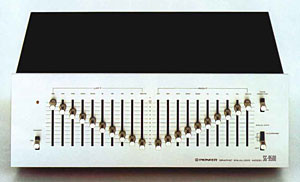The Pioneer SG-9500, a ten-band stereo graphic equalizer produced from 1976 to 1979, stands as a testament to Pioneer’s commitment to audio fidelity and user-centric design during the golden age of hi-fi. This meticulously engineered component goes beyond simple program source equalization, offering precise tonal adjustments for playback equipment, speakers, and even the listening environment itself. In an era where vinyl reigned supreme and tape decks were essential, the Pioneer SG-9500 empowered audiophiles to sculpt their sound with unparalleled control.
 Pioneer SG-9500 Stereo Graphic Equalizer
Pioneer SG-9500 Stereo Graphic Equalizer
Precision Audio Shaping with the Pioneer SG-9500
At its core, the Pioneer SG-9500 is designed to provide comprehensive control over the audio spectrum. It allows users to fine-tune sound reproduction to match not only their personal preferences but also the acoustic characteristics of their listening space. This level of control was particularly valuable in the 1970s, when home audio setups were becoming increasingly sophisticated, and listeners were more attuned to the nuances of sound reproduction. The SG-9500’s ability to correct for imperfections in recordings or tailor the sound profile to individual tastes made it a highly sought-after component for discerning audiophiles.
Key Features and Functionality
The Pioneer SG-9500 boasts an array of features that set it apart as a versatile and powerful audio tool. Its ten individual frequency bands, centered at 32Hz, 64Hz, 125Hz, 500Hz, 1kHz, 2kHz, 4kHz, 8kHz, and 16kHz, offer granular control over the audio spectrum. Each band provides a control range of ±10dB, allowing for subtle enhancements or more pronounced sonic alterations. This precise control makes the SG-9500 ideal for addressing specific frequency imbalances in recordings, optimizing speaker performance, or compensating for room acoustics.
Beyond its equalization capabilities, the SG-9500 is built with high-quality components to ensure pristine audio signal processing. Its specifications reflect this commitment to quality, with a frequency response spanning from 5Hz to 70kHz, a signal-to-noise ratio of 90dB, and a low total harmonic distortion of just 0.04%. These technical specifications translate to a clean, transparent, and accurate audio performance, ensuring that the equalization process enhances rather than degrades the original sound quality. The unit is also robustly constructed, weighing in at 6.9kg and featuring a solid build quality typical of Pioneer’s equipment from this era.
Technical Specifications at a Glance
For audiophiles and vintage hi-fi enthusiasts, the technical specifications of the Pioneer SG-9500 highlight its engineering excellence:
- Output Level: 1V (6V max)
- Gain: ± 0dB
- Frequency Response: 5Hz to 70kHz
- Signal to Noise Ratio: 90dB
- Total Harmonic Distortion: 0.04%
- Control Range: ± 10dB
- Frequency Bands: 32, 64, 125, 250, 500, 1K, 2K, 4K, 8K, 16KHz (Note: original text missed 250Hz band which is present in reviews and common knowledge about 10-band EQs of this era)
- Semiconductors: 14 x IC, 2 x FET, 12 x transistors, 13 x diodes
- Dimensions: 420 x 150 x 341mm
- Weight: 6.9kg
- Year: 1978
Community Reviews and User Experiences
The enduring appeal of the Pioneer SG-9500 is further evidenced by user reviews, with many owners praising its performance, build quality, and aesthetic appeal. Reviewers on platforms like HiFi Engine consistently highlight its ability to provide tight and precise control over frequencies, making it an invaluable tool for optimizing their audio systems. Users often pair the SG-9500 with other Pioneer components from the same era, such as the SA-9500 amplifier, to create a cohesive and high-performing vintage setup.
One reviewer, Jim Libert, noted the superior build quality of the SG-9500 compared to later models, emphasizing the use of robust sliders instead of plastic ones prone to breakage. Another user, rtksjones, expressed their love for the equalizer after rescuing and restoring one, highlighting its excellent frequency control and synergy with the SA-9500 amplifier. Selenium10 humorously admitted to purchasing the SG-9500 primarily for its stunning aesthetics, describing it as “arguably the most beautiful equalizer in the galaxy” and an “expensive piece of furniture” that also sounds great. These reviews collectively paint a picture of a well-regarded and highly functional piece of audio equipment that continues to be appreciated by vintage hi-fi enthusiasts.
Conclusion: The Pioneer SG-9500 Legacy
The Pioneer SG-9500 stands as a remarkable example of audio engineering from the 1970s. Its precise ten-band equalization, coupled with high-fidelity specifications and robust construction, made it a standout component in its time and continues to make it desirable in the vintage audio market today. Whether you are a seasoned audiophile looking to refine your vintage hi-fi system or a newcomer eager to explore the rich soundscapes of classic audio equipment, the Pioneer SG-9500 offers a unique blend of functionality, aesthetics, and enduring quality. Its legacy as a top-tier stereo graphic equalizer is well-deserved, solidifying its place in the history of high-fidelity audio.
